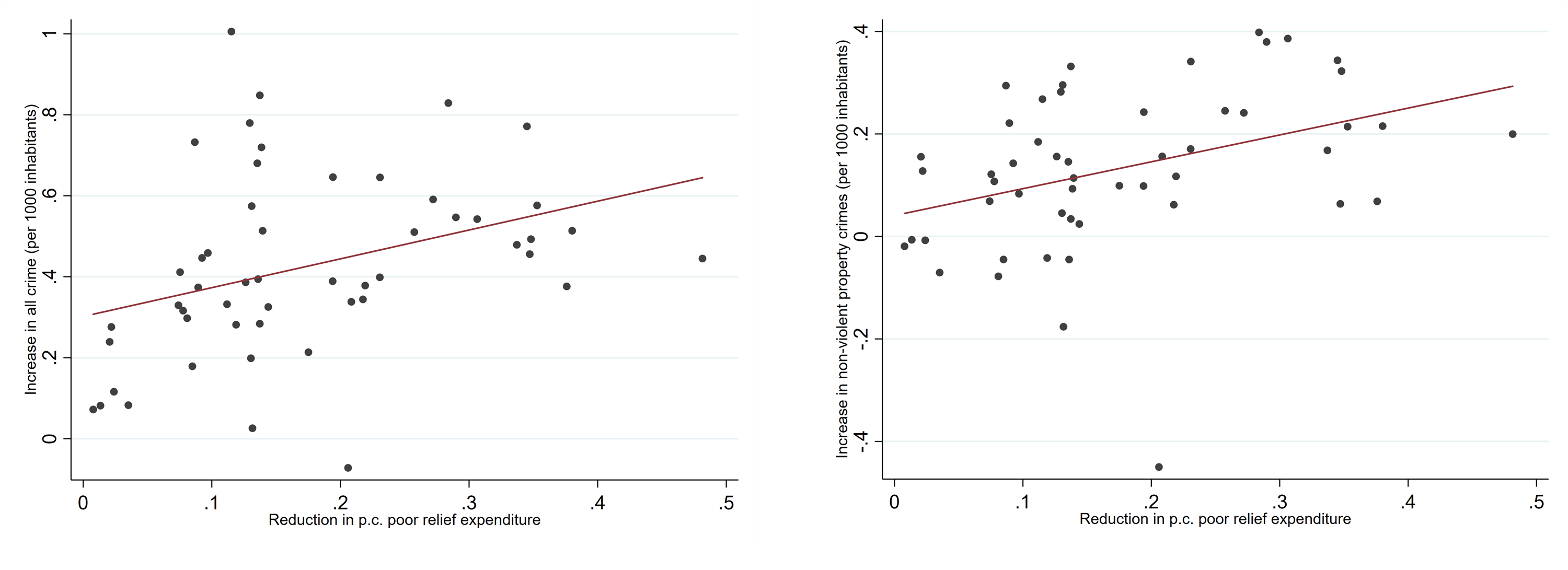Welfare cuts and crime in 19th-century England and Wales

Welfare cuts and crime in 19th-century England and Wales
Friday 26 Mar 2021In 1834, the New Poor Law completely overhauled the system of poor relief across England and Wales and dramatically reduced welfare payments to the poor. Eric Melander and Martina Miotto explore an unintended consequence of these cuts: an increase in petty property crime.
The Poor Law Amendment Act, 1834 (the ‘New Poor Law’) was one of the most important pieces of legislation in nineteenth-century Britain. Passed in response to the increasing costs of the old system of poor relief, which had been in place since Elizabethan times and accounted for approximately one-fifth of national expenditure by 1830, it standardised the administration of poor relief across England and Wales.
Workhouses formed the backbone of the new system, where paupers could seek relief in exchange for their work. Relief outside workhouses was formally abolished, and the conditions inside them were purposefully chosen to deter any but the most destitute from seeking relief.
These changes brought about a sharp reduction in overall poor relief expenditures (fig. 1). Interestingly, reductions were not uniform across England and Wales. Rather, counties which had previously been spending relatively more on poor relief (in per capita terms) saw more pronounced drops following the implementation of the New Poor Law.
Figure 1: Per-capita poor relief spending in English and Welsh counties 1820–42

Note: Timeline showing per-capita poor relief spending in English and Welsh counties over the period 1820-1842. Solid line plots the average level of spending each year. Dashed and dot-dashed lines plot average spending by two subsamples of counties: those with above-median (dashed) and below-median (dot-dashed) average pre-reform spending. Vertical red line indicates the year of the Poor Law Amendment Act 1834.
What were the effects of curbing poor relief expenditures? Policymakers and commentators at the time – including, famously, the cleric and political economist Thomas Malthus – hoped that a more austere system would deter population growth and eliminate various social costs, such as able-bodied unemployment, allegedly caused by the Old Poor Law. It is unclear whether these goals were achieved, or, indeed, whether the perceived social costs of the old system were very large in the first place (Clark and Page, 2019).
But new county-level data on criminal activity before and after the New Poor Law reveal an unintended consequence of the reform: the counties that saw the sharpest drops in welfare spending in 1834 subsequently saw the largest increases in crime (fig. 2). This relationship was most pronounced for non-violent property crime, including larceny, cattle theft and poaching.
Figure 2: Relationship between reductions in per capita poor relief spending and increases in criminal charges per 1000 habitants

Note: Correlational scatter plots showing the relationship between reductions in per capita poor relief spending (defined as average spending pre-1834 less average spending post-1834) and increases in criminal charges per 1000 inhabitants. Left: all crimes. Right: non-violent property crimes only. Each dot represents one county.
It appears that, faced with a less generous system of poor relief under the New Poor Law, the economically vulnerable became more willing to take the risks associated with committing a crime. The risky gains from breaking the law substituted for what had previously been afforded through receipt of poor relief. Qualitative work on the ‘economy of makeshifts’ (the strategies of the poor for material survival) supports this interpretation (Ager, 2014): illicit activities increasingly became a coping mechanism in the face of economic hardship.
Detailed records of over 250,000 individuals brought to trial between 1828 and 1840 reveal additional important patterns. The relationship between poor relief spending and crime was particularly strong during the agricultural off-season, suggesting that seasonal labourers were particularly hard-hit by the compounding effects of welfare cuts and precarious work opportunities.
These findings from history underscore a key trade-off that must be faced by policymakers today: savings from welfare cuts must be weighed against their direct and indirect social costs.
Eric Melander, University of Namur and CAGE
Martina Miotto, CERGE-EI and CAGE
Further reading
Ager, A. W. (2014), Crime and Poverty in Nineteenth-Century England: The Economy of Makeshifts, A&C Black.
Clark, G. and Page, M. E. (2019), Welfare reform, 1834: Did the New Poor Law in England produce significant economic gains?, Cliometrica 13(2), 221–244.
Melander, E. and Miotto, M. (2021), Welfare cuts and crime: Evidence from the New Poor LawLink opens in a new window, CAGE working paper (no. 548)
Image credit:Everett Collection / Shutterstock.com
